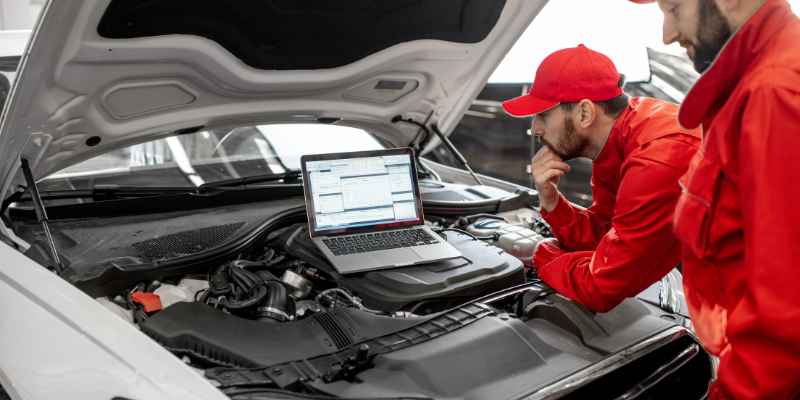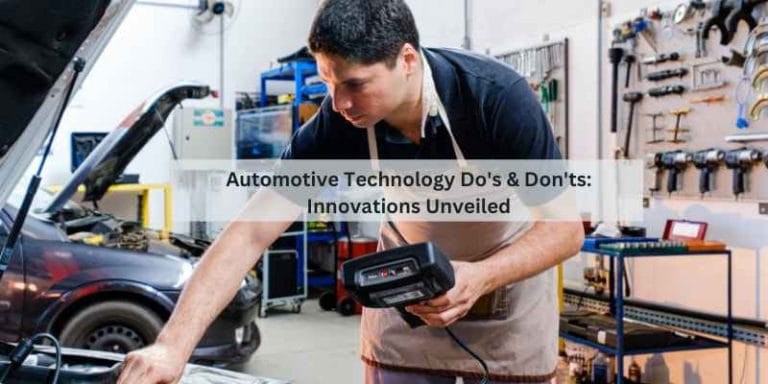Automotive Technology Description: Innovations and Advances
Automotive technology encompasses the study and application of vehicle design, technology, and maintenance. It includes the repair, maintenance, and inspection of various automotive systems, such as engines and safety features.
Automotive technology also involves the use of different fuel and energy sources, including diesel, electric, and alternative substances like ethanol. The automotive industry, which encompasses a wide range of activities related to motor vehicles, relies on the expertise of automotive technicians to ensure the proper functioning and safety of vehicles.
With a focus on hands-on experience and technical knowledge, automotive technology plays a critical role in keeping vehicles operating efficiently and safely. From basic maintenance to complex repairs, automotive technology is essential for maintaining the performance and longevity of automobiles.
The Evolution Of Automotive Technology
Milestones In Vehicle Innovation
Throughout history, the automotive industry has witnessed remarkable milestones in vehicle innovation.
The Shift To Electric And Hybrid Models
The automotive landscape is experiencing a significant shift towards electric and hybrid models.
Cutting-edge Features In Modern Vehicles
Advanced Driver-assistance Systems (adas)
ADAS in modern vehicles includes features like lane departure warning, adaptive cruise control, and automatic emergency braking.
Connectivity And Infotainment
Vehicles now offer seamless smartphone integration, voice commands, and high-definition touchscreens for entertainment and navigation.
The Role Of Artificial Intelligence
Artificial Intelligence (AI) plays a pivotal role in shaping the future of automotive technology. From enhancing safety to optimizing maintenance, AI is revolutionizing the automotive industry.
Ai In Autonomous Vehicles
Autonomous vehicles rely heavily on AI to perceive their surroundings, make decisions, and navigate without human intervention. Through advanced algorithms and machine learning, AI enables these vehicles to analyze complex scenarios and react in real time, ensuring safer and more efficient transportation.
Predictive Maintenance And Ai
AI-driven predictive maintenance systems harness data to anticipate potential issues before they occur, allowing for proactive maintenance. By monitoring vehicle performance and identifying patterns, AI helps prevent unexpected breakdowns, minimizing downtime and reducing overall maintenance costs.
Alternative Fuel Technologies
Alternative Fuel Technologies are paving the way for a greener and more sustainable future in the automotive industry. With the growing concern for environmental impact, the focus on developing vehicles powered by alternative fuels has intensified. From Electric Vehicles (EVs) and Batteries to Hydrogen Fuel Cells and Biofuels, these technologies are revolutionizing the way we power our vehicles.
Electric Vehicles (evs) And Batteries
Electric Vehicles (EVs) are at the forefront of the automotive industry’s shift towards sustainability. These vehicles are powered by electric motors and rechargeable batteries, eliminating the need for traditional internal combustion engines. The advancement in battery technology has significantly extended the driving range of EVs, making them a viable option for daily commuting and long-distance travel.
Hydrogen Fuel Cells And Biofuels
Hydrogen Fuel Cells are gaining attention as a promising alternative to traditional gasoline-powered vehicles. These cells generate electricity by harnessing the chemical reaction between hydrogen and oxygen, producing water vapor as the only emission. Biofuels, derived from organic matter such as plants and algae, offer a renewable and eco-friendly fuel option for vehicles, reducing greenhouse gas emissions and reliance on fossil fuels.
Automotive Safety Enhancements
Active Safety Features
Active safety features are designed to prevent accidents by helping the driver maintain control of the vehicle and avoid collisions. These features often use advanced technology such as sensors, cameras, and radar to monitor the surroundings and provide real-time assistance to the driver. Some common active safety features include:
- Anti-lock braking system (ABS) to prevent wheel lockup during hard braking
- Electronic stability control (ESC) to help maintain vehicle stability during sudden maneuvers
- Adaptive cruise control to automatically adjust the vehicle’s speed to maintain a safe following distance
- Lane departure warning systems to alert the driver when the vehicle drifts out of its lane
Passive Safety Innovations
Passive safety innovations are designed to protect vehicle occupants in the event of a crash. These features do not require any action from the driver and are activated automatically during a collision. Some examples of passive safety innovations include:
- Seat belts with pretensioners and load limiters to minimize the impact on occupants
- Advanced airbag systems that deploy in stages based on the severity of the collision
- Reinforced vehicle structures and crumple zones to absorb and dissipate crash forces
The Impact Of Automotive Tech On The Environment
The automotive industry has made significant advancements in technology, which has had both positive and negative impacts on the environment. As the industry continues to evolve, it becomes crucial to explore the effects of automotive technology on the environment.
Emission Control Technologies
Emission control technologies play a vital role in reducing the environmental impact of vehicles. These technologies include catalytic converters, exhaust gas recirculation (EGR) systems, and selective catalytic reduction (SCR) systems. Catalytic converters help in converting harmful pollutants into less harmful emissions, while EGR and SCR systems reduce nitrogen oxide emissions. The implementation of these technologies has led to a significant decrease in harmful emissions, contributing to a cleaner environment.
Sustainable Manufacturing Practices
Sustainable manufacturing practices have become increasingly important in the automotive industry. Automakers are focusing on incorporating sustainable materials, reducing energy consumption, and implementing efficient waste management practices in their manufacturing processes. By adopting sustainable practices, the industry aims to minimize its environmental footprint, conserve natural resources, and reduce pollution. This shift towards sustainable manufacturing is a positive step towards creating a more eco-friendly automotive sector.
The Future Of Automotive Design

Aerodynamic Developments
In the realm of automotive design, aerodynamic developments play a crucial role in enhancing vehicle performance and fuel efficiency. By incorporating sleek designs and advanced aerodynamic principles, manufacturers are able to reduce drag and improve overall vehicle stability.
Material Advancements For Efficiency
Continual material advancements are revolutionizing automotive design, paving the way for lighter, stronger, and more efficient vehicles. From carbon fiber composites to advanced alloys, these materials are not only enhancing performance but also contributing to sustainability efforts.
Challenges And Considerations In Automotive Tech
As automotive technology advances, several challenges and considerations come to the forefront. From ensuring cybersecurity for connected cars to addressing ethical concerns in self-driving tech, the automotive industry faces complex issues that require careful navigation.
Cybersecurity For Connected Cars
Cybersecurity is a critical aspect of connected cars, with the rise of IoT devices in vehicles leaving them vulnerable to cyber threats. Ensuring robust security measures is essential to protect sensitive data and prevent unauthorized access to vehicle systems.
Ethical Considerations In Self-driving Tech
Self-driving technology raises important ethical considerations, such as determining liability in case of accidents and addressing the moral implications of autonomous decision-making. Navigating these ethical dilemmas is crucial for the responsible development and deployment of self-driving vehicles.
Educational Pathways In Automotive Technology
Embarking on a career in Automotive Technology involves pursuing specific educational pathways that equip individuals with the necessary skills and knowledge to excel in the field.
Degree Programs And Certifications
Individuals interested in Automotive Technology can opt for various degree programs and certifications to enhance their expertise:
- Associate Degree in Automotive Technology: Provides comprehensive training in vehicle diagnostics, repair, and maintenance.
- Bachelor’s Degree in Automotive Engineering: Focuses on advanced topics like automotive design and manufacturing processes.
- ASE Certifications: Offered by the National Institute for Automotive Service Excellence, these certifications validate technicians’ skills in specific areas.
Career Opportunities And Job Market
Upon completing their education in Automotive Technology, individuals can explore diverse career opportunities in a thriving job market:
- Automotive Service Technicians: Responsible for diagnosing and repairing vehicle issues.
- Automotive Engineers: Design and develop new automotive systems and components.
- Service Managers: Oversee service departments and ensure efficient operations.
Consumer Adaptation To New Automotive Tech
Consumers are rapidly adapting to new automotive technologies, including advanced safety features, electric vehicles, and autonomous driving systems. These advancements are revolutionizing the driving experience and reshaping the future of transportation. With the increasing demand for sustainability and connectivity, the automotive industry is evolving to meet the changing needs of consumers.
As the automotive industry continues to evolve, new technologies are being introduced at a rapid pace. These technologies have the potential to improve safety, increase fuel efficiency, and enhance the overall driving experience. However, for consumers, adapting to these new technologies can be a challenge. In this section, we will explore how consumers are adapting to new automotive tech, including their user experience with new features and adoption rates and market trends.
User Experience With New Features
When it comes to new automotive tech, user experience is key. Consumers want technology that is intuitive and easy to use. Manufacturers are responding to this demand by designing features that are more user-friendly than ever before. For example, many new cars now come equipped with touchscreen displays that allow drivers to control everything from the radio to the climate control system with just a few taps on the screen.
Adoption Rates And Market Trends
While new automotive technologies are becoming more user-friendly, not all consumers are quick to adopt them. Adoption rates vary depending on the technology and the demographic group. For example, younger consumers tend to be more willing to adopt new technologies than older consumers. Additionally, some technologies are more popular in certain regions than in others.
Manufacturers are closely monitoring adoption rates and market trends to determine which technologies are worth investing in. For example, electric vehicles are becoming increasingly popular as consumers become more environmentally conscious. As a result, many manufacturers are investing in electric vehicle technology and developing new models to meet consumer demand.
In conclusion, consumer adaptation to new automotive tech is an ongoing process. Manufacturers are constantly introducing new technologies, and consumers are constantly adapting to them. By understanding user experience with new features and adoption rates and market trends, manufacturers can better design technologies that meet consumer needs and preferences.

Frequently Asked Questions
What Is The Job Description Of Automotive Technology?
Automotive technology involves maintaining and repairing vehicles, performing basic care, and explaining repairs to clients. It focuses on inspecting, maintaining, and repairing cars and trucks using various energy sources. The job includes addressing automotive problems and adhering to manufacturer and client specifications.
What Are The Functions Of Automotive Technology?
Automotive technology involves constructing, inspecting, maintaining, and repairing cars and trucks using various substances such as diesel, gasoline, electric, and alternative fuels like ethanol. The functions of automotive technology include performing basic care and maintenance, repairing or replacing worn parts, and explaining automotive problems and repairs to clients.
The automotive industry comprises a wide range of companies involved in the design, development, manufacturing, marketing, selling, repairing, and modification of motor vehicles.
What Is Automotive Systems Technology?
Automotive Systems Technology involves applying technical skills to repair and maintain various types of vehicles.
What Is The Description Of Automotive?
Automotive technology involves maintaining, repairing, and designing vehicles. It includes tasks like changing oil, repairing parts, and explaining repairs to clients.
Conclusion
Automotive technology is a vast field that deals with the construction, inspection, maintenance, and repair of vehicles. It includes diesel, electric, gasoline, and alternative substances like ethanol. The job description of an automotive technician involves performing basic care and maintenance, repairing or replacing worn parts, and explaining automotive problems to clients.
With the increasing demand for vehicles, the industry offers numerous job opportunities for individuals with a degree in automotive technology. Keeping up with the latest advancements in the field is essential for success in this dynamic industry.







